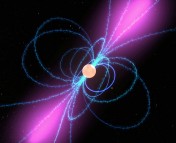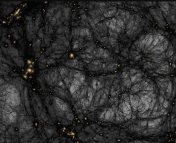Title: Primordial Black Holes and r-Process Nucleosynthesis
Authors: George M. Fuller, Alexander Kusenko, and Volodymyr Takhistov
First Author’s Institution: University of California, San Diego
Status: Published in Physical Review Letters (open access)
Neutron stars have little to fear from most things. With impenetrable crusts ten billion times stronger than steel, magnetic fields strong enough to tear apart atoms, and rotating beams of almighty destruction, they are well defended.
However, today’s paper suggests that one thing might strike fear in the hearts of neutron stars all around: black holes that date back from the Big Bang itself. And maybe, just maybe, some of the basic building blocks of our world might come out of this grisly act of predation.
Small Mouths and Bottomless Stomachs
Primordial black holes are hypothetical black holes that are thought to have potentially formed shortly after the Big Bang. Those with far less mass than the Sun (10-14 to 10-8 solar masses; about the mass of an asteroid to the mass of a moon) are candidates for some of the dark matter, the invisible mass that makes up most of the matter in the Universe. It is thought that the primordial black hole density in our Galaxy would be highest at the Galactic center, as this is where dark matter is most abundant. Seemingly coincidentally, the Galactic center is relatively bereft of pulsars, rapidly rotating neutron stars that possess beams of radiation that rotate in and out of our view. Perhaps, the authors argue, the two are correlated.
When a primordial black hole collides with a pulsar, the sheer density of the neutron star causes the black hole to become embedded in the star’s core. Once inside the core, the overwhelming pressure provides the black hole with a constant supply of food, and it eats the pulsar from the inside out. The pulsar spins up as it shrinks due to conservation of angular momentum, like a figure skater pulling in their arms. Eventually, the speed of its surface at the equator reaches escape velocity. A decent fraction of the pulsar’s mass ends up being violently ejected from the system, as shown in Figure 1. The authors calculate that if we take the shortest observed period of a pulsar (1.56 ms) as the fastest initial rotation possible, then the average mass ejected is a tenth of a solar mass. Even though the average pulsar has a mass 1.5 times the Sun’s and is orders of magnitude larger than a primordial black hole (~10 km radius compared to 0.03 mm at largest), the remaining matter is completely consumed by the black hole. This violent demise could explain the relative lack of pulsars in the Galactic center—there are just too many primordial black holes on the prowl!

The Heavy Metal Alchemist
Primordial black holes could also be a source of r-process elements. The r-process is one of the main formation mechanisms for elements heavier than iron, such as gold and iodine. It occurs when atomic nuclei are bombarded by so many free neutrons that the atoms have no time to radioactively decay before they absorb more neutrons. Eventually, once the neutron flux ceases, the neutron-rich nuclei can undergo processes like fission and beta decay, turning into new elements. The high level of free neutrons this process requires restricts it to extreme environments, traditionally thought to be supernovae or neutron star collisions.
The disintegrating chunks of pulsar released by a primordial black hole during its feeding frenzy could be another location where the r-process occurs. Decompression of the ejecta would release a huge quantity of free neutrons that could then power r-process nuclear reactions. If 0.1-0.5 solar masses of pulsar guts are ejected in each act of primordial black hole predation, then it would take a hundred thousand neutron star disruption events to account for all the r-process element mass of the Galaxy. Whether or not this is feasible depends on the mass of the primordial black holes and the fraction of dark matter that they make up (Figure 2). The authors calculate that there are ranges of mass and abundance for the primordial black holes that are consistent with current observations and that can explain r-process element abundances.

Neutron star demise may also explain the non-repeating fast radio bursts that have been observed. In its final death throes, a consumed pulsar may release 1041-1043 ergs of energy that was previously stored in its magnetic fields. That’s 1 to 100 times as much energy as the Sun makes in a year! This cry of agony would radiate out in a burst of radio waves lasting a few milliseconds, which fits the profile of a fast radio burst. It is also expected to create a kilonova, an explosion 1/10th – 1/100th as bright as a regular supernova
.…So the next time you hold a piece of gold jewelry, look carefully at it, treasure it, and thank the neutron stars that likely died to bring it into being. Who knows, some of them may even have been a black hole’s dinner!
Astrobite edited by: Sahil Hegde, Huei Sears
Featured image credit: Alexander Kusenko/UCLA





Thanks for the work you do putting this together! So interesting
A very interesting read, thank you! Btw, any comics to share? They sound just as cool
Just click the Tumblr link on my bio and go through the archives, you’ll find plenty :3
Thank you!
This predicts that there would be a lot of ~ 1 – 1.5 solar masses, produced by the eating of neutron stars. These masses cannot be produced by normal astrophysical processes and could be detected by X ray flares or possibly the EHT (as they spiral into the central massive black hole).